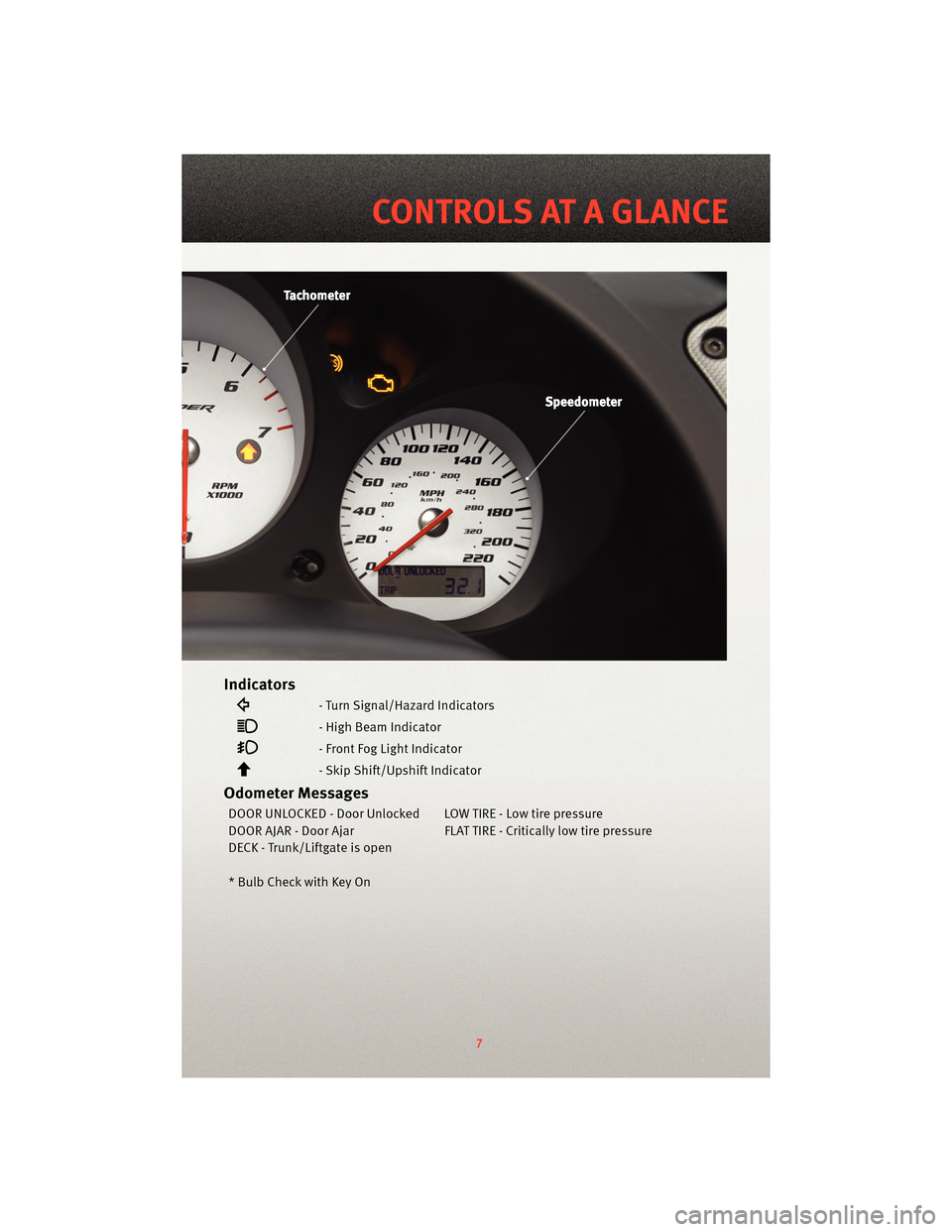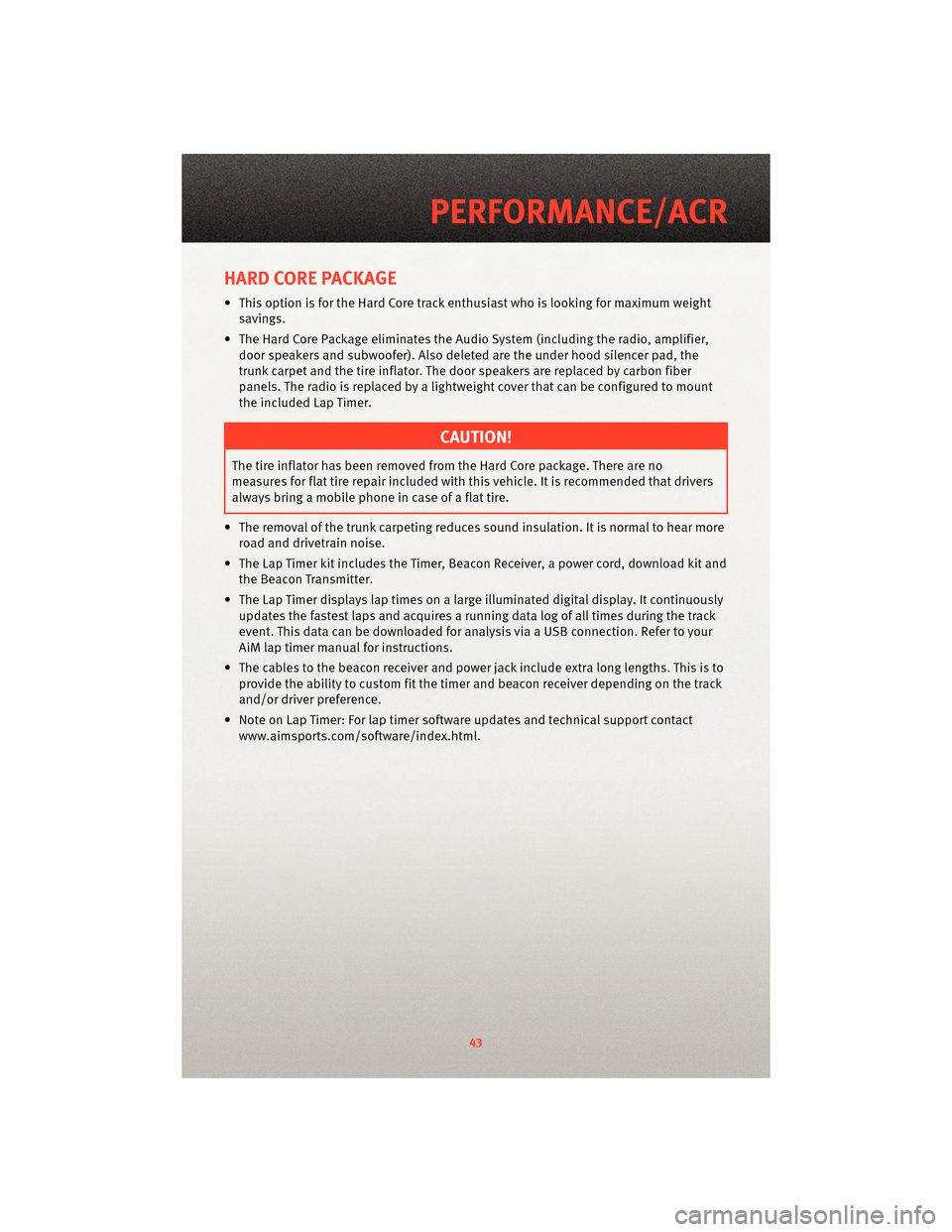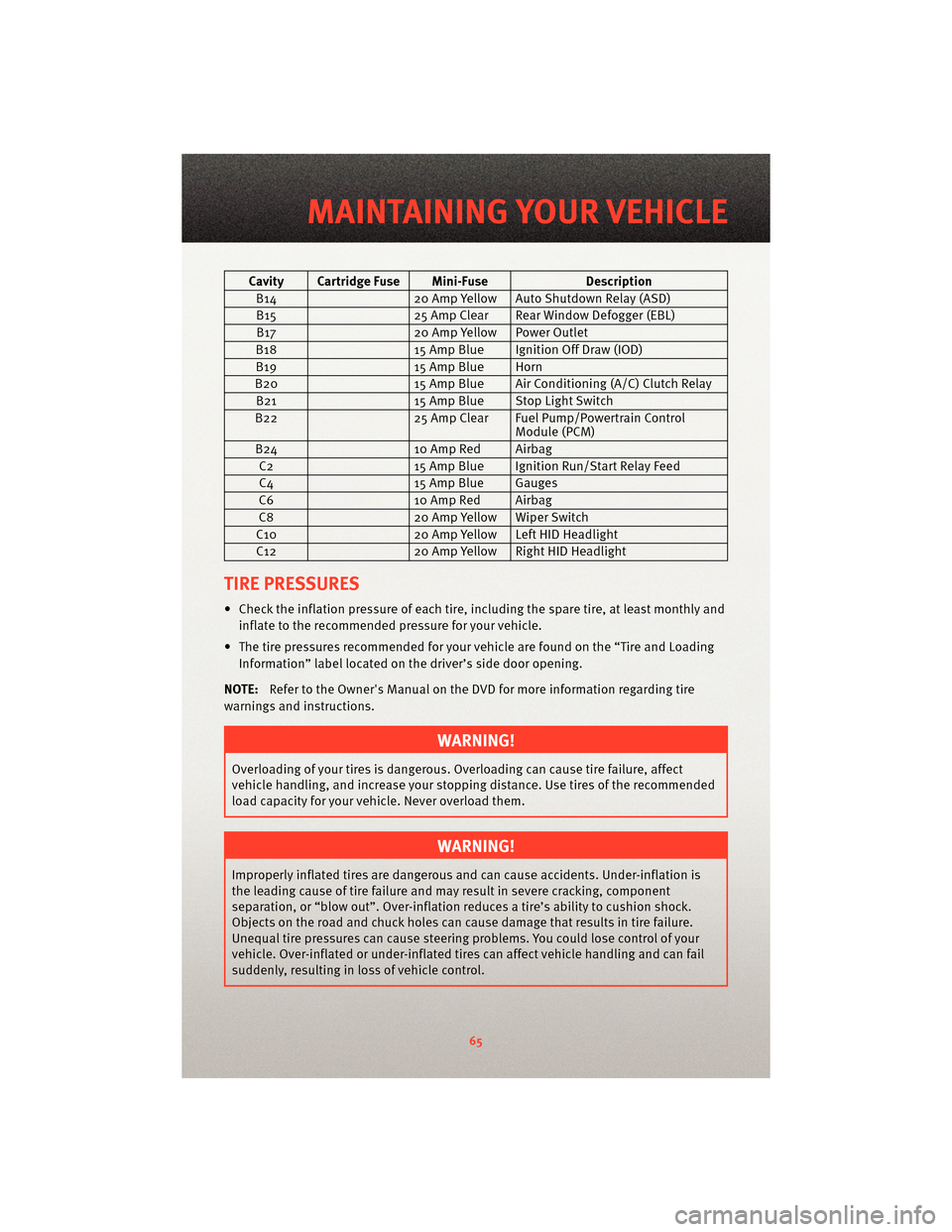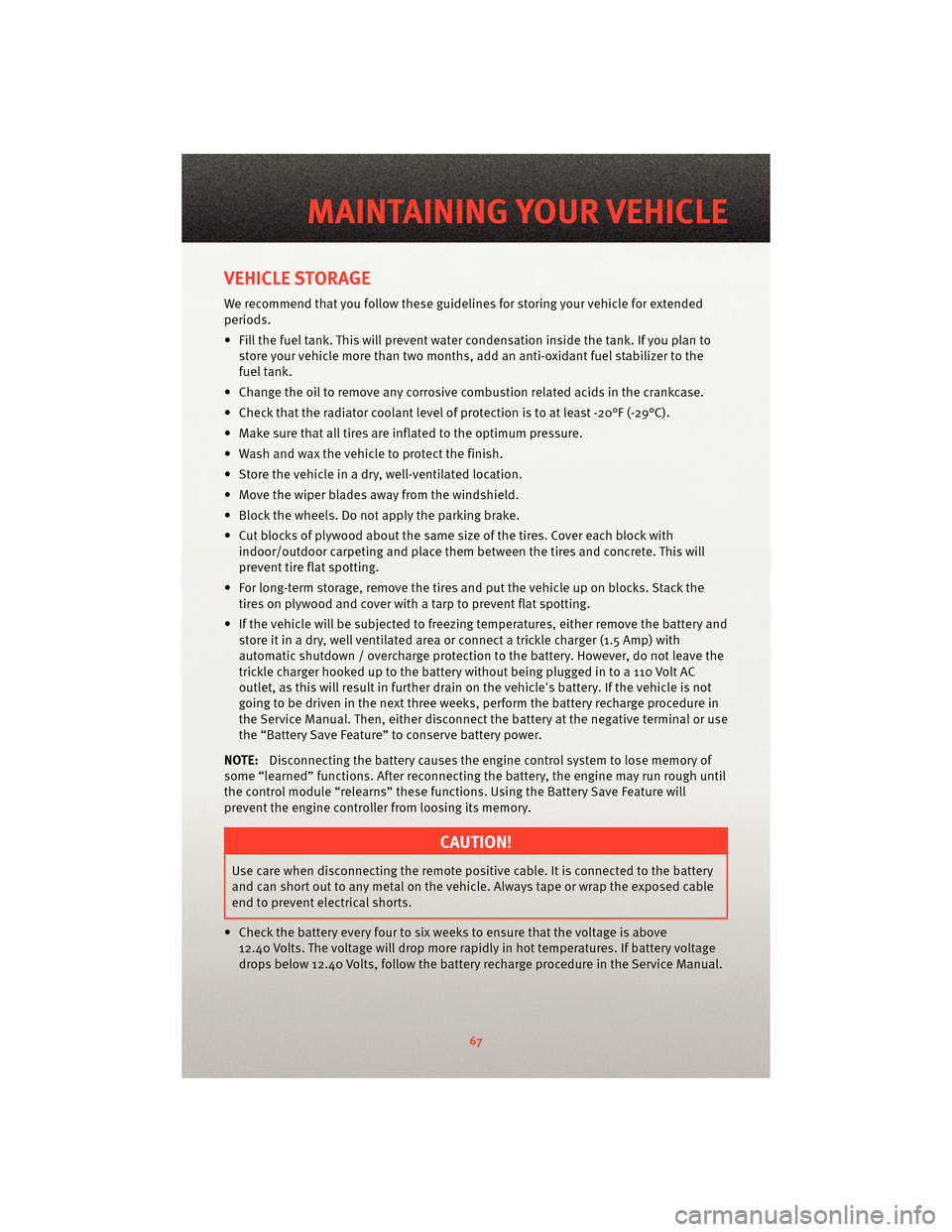run flat DODGE VIPER 2010 ZB II / 2.G User Guide
[x] Cancel search | Manufacturer: DODGE, Model Year: 2010, Model line: VIPER, Model: DODGE VIPER 2010 ZB II / 2.GPages: 80, PDF Size: 8.08 MB
Page 9 of 80

Indicators
- Turn Signal/Hazard Indicators
- High Beam Indicator
- Front Fog Light Indicator
- Skip Shift/Upshift Indicator
Odometer Messages
DOOR UNLOCKED - Door Unlocked LOW TIRE - Low tire pressure
DOOR AJAR - Door Ajar FLAT TIRE - Critically low tire pressure
DECK - Trunk/Liftgate is open
* Bulb Check with Key On
7
CONTROLS AT A GLANCE
Page 45 of 80

HARD CORE PACKAGE
• This option is for the Hard Core track enthusiast who is looking for maximum weight
savings.
• The Hard Core Package eliminates the Audio System (including the radio, amplifier,
door speakers and subwoofer). Also delet ed are the under hood silencer pad, the
trunk carpet and the tire inflator. The door speakers are replaced by carbon fiber
panels. The radio is replaced by a lightweight cover that can be configured to mount
the included Lap Timer.
CAUTION!
The tire inflator has been removed from the Hard Core package. There are no
measures for flat tire repair included with this vehicle. It is recommended that drivers
always bring a mobile phone in case of a flat tire.
• The removal of the trunk carpeting reduces sound insulation. It is normal to hear more road and drivetrain noise.
• The Lap Timer kit includes the Timer, Beacon Receiver, a power cord, download kit and the Beacon Transmitter.
• The Lap Timer displays lap times on a large illuminated digital display. It continuously updates the fastest laps and acquires a running data log of all times during the track
event. This data can be do wnloaded for analysis via a USB connection. Refer to your
AiM lap timer manual for instructions.
• The cables to the beacon receiver and power jack include extra long lengths. This is to provide the ability to custom fit the timer and beacon receiver depending on the track
and/or driver preference.
• Note on Lap Timer: For lap timer software updates and technical support contact www.aimsports.com/software/index.html.
43
PERFORMANCE/ACR
Page 67 of 80

Cavity Cartridge Fuse Mini-FuseDescription
B14 20 Amp Yellow Auto Shutdown Relay (ASD)
B15 25 Amp Clear Rear Window Defogger (EBL)
B17 20 Amp Yellow Power Outlet
B18 15 Amp Blue Ignition Off Draw (IOD)
B19 15 Amp Blue Horn
B20 15 Amp Blue Air Conditioning (A/C) Clutch Relay
B21 15 Amp Blue Stop Light Switch
B22 25 Amp Clear Fuel Pump/Powertrain Control
Module (PCM)
B24 10 Amp Red Airbag
C2 15 Amp Blue Ignition Run/Start Relay Feed
C4 15 Amp Blue Gauges
C6 10 Amp Red Airbag
C8 20 Amp Yellow Wiper Switch
C10 20 Amp Yellow Left HID Headlight
C12 20 Amp Yellow Right HID Headlight
TIRE PRESSURES
• Check the inflation pressure of each tire, including the spare tire, at least monthly and
inflate to the recommended pressure for your vehicle.
• The tire pressures recommended for your vehicle are found on the “Tire and Loading Information” label located on the driver’s side door opening.
NOTE: Refer to the Owner's Manual on the DVD f or more information regarding tire
warnings and instructions.
WARNING!
Overloading of your tires is dangerous. Ov erloading can causetire failure, affect
vehicle handling, and increase your stopping distance. Use tires of the recommended
load capacity for your vehicle. Never overload them.
WARNING!
Improperly inflated tires are dangerous and can cause accidents. Under-inflation is
the leading cause of tire failure and may result in severe cracking, component
separation, or “blow out”. Over-inflation r educes a tire’s ability to cushion shock.
Objects on the road and chuck holes can cause damage that results in tire failure.
Unequal tire pressures can cause steering problems. You could lose control of your
vehicle. Over-inflated or under-inflated ti res can affect vehicle handling and can fail
suddenly, resulting in loss of vehicle control.
65
MAINTAINING YOUR VEHICLE
Page 69 of 80

VEHICLE STORAGE
We recommend that you follow these guidelines for storing your vehicle for extended
periods.
• Fill the fuel tank. This will prevent water condensation inside the tank. If you plan to store your vehicle more than two months, add an anti-oxidant fuel stabilizer to the
fuel tank.
• Change the oil to remove any corrosive combustion related acids in the crankcase.
• Check that the radiator coolant level of protection is to at least -20°F (-29°C).
• Make sure that all tires are inflated to the optimum pressure.
• Wash and wax the vehicle to protect the finish.
• Store the vehicle in a dry, well-ventilated location.
• Move the wiper blades away from the windshield.
• Block the wheels. Do not apply the parking brake.
• Cut blocks of plywood about the same size of the tires. Cover each block with indoor/outdoor carpeting and place them between the tires and concrete. This will
prevent tire flat spotting.
• For long-term storage, remove the tires and put the vehicle up on blocks. Stack the tires on plywood and cover wit h a tarp to prevent flat spotting.
• If the vehicle will be subjected to freezin g temperatures, either remove the battery and
store it in a dry, well ventilated area or connect a trickle charger (1.5 Amp) with
automatic shutdown / overcharge protection to the battery. However, do not leave the
trickle charger hooked up to the battery without being plugged in to a 110 Volt AC
outlet, as this will result in further drain on the vehicle's battery. If the vehicle is not
going to be driven in the next three weeks, per form the battery recharge procedure in
the Service Manual. Then, either disconnect the b attery at the negative terminal or use
the “Battery Save Feature” to conserve battery power.
NOTE: Disconnecting the battery causes the en gine control system to lose memory of
some “learned” functions. After reconnecting the b attery, the engine may run rough until
the control module “relearns” these functions. Using the Battery Save Feature will
prevent the engine controller from loosing its memory.
CAUTION!
Use care when disconnecting the remote positive cable. It is connected to the battery
and can short out to any metal on the vehicle. Always tape or wrap the exposed cable
end to prevent electrical shorts.
• Check the battery every four to six weeks to ensure that the voltage is above 12.40 Volts. The voltage will drop more rapidly in hot temperatures. If battery voltage
drops below 12.40 Volts, follow the battery r echarge procedure in the Service Manual.
67
MAINTAINING YOUR VEHICLE